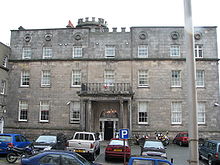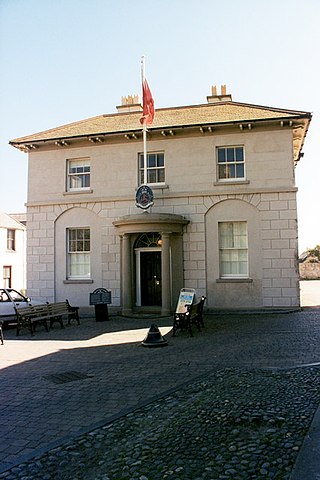
The Isle of Man had become physically separated from Great Britain and Ireland by 6500 BC. It appears that colonisation took place by sea sometime during the Mesolithic era. The island has been visited by various raiders and trading peoples over the years. After being settled by people from Ireland in the first millennium AD, the Isle of Man was converted to Christianity and then suffered raids by Vikings from Norway. After becoming subject to Norwegian suzerainty as part of the Kingdom of Mann and the Isles, the Isle of Man later became a possession of the Scottish and then the English crowns.

Blair Atholl is a village in Perthshire, Scotland, built about the confluence of the Rivers Tilt and Garry in one of the few areas of flat land in the midst of the Grampian Mountains. The Gaelic place-name Blair, from blàr, 'field, plain', refers to this location. Atholl, which means 'new Ireland', from the archaic Ath Fhodla is the name of the surrounding district.
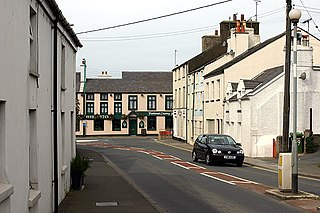
Ballasalla is a village in the parish of Malew in the south-east of the Isle of Man. The village is situated close to the Isle of Man Airport and 2 miles (3 km) north-east of the town of Castletown.
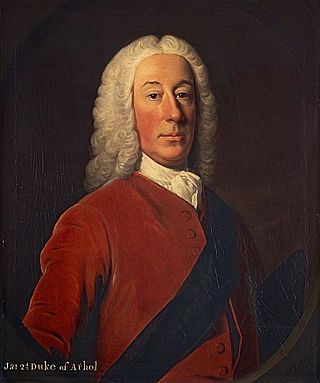
James Murray, 2nd Duke of Atholl,, styled Marquess of Tullibardine between 1715 and 1746, was a Scottish peer, and Lord Privy Seal.

John Murray, 3rd Duke of Atholl, KT, PC, known as John Murray until 1764, was a Scottish peer and Tory politician.

John Murray, 4th Duke of Atholl, KT, PC, FRS, styled Marquess of Tullibardine from 1764 to 1774, was a Scottish peer.

Clan Murray is a Highland Scottish clan. The chief of the Clan Murray holds the title of Duke of Atholl. Their ancestors were the Morays of Bothwell who established the family in Scotland in the 12th century. In the 16th century, descendants of the Morays of Bothwell, the Murrays of Tullibardine, secured the chiefship of the clan and were created Earls of Tullibardine in 1606. The first Earl of Tullibardine married the heiress to the Stewart earldom of Atholl and Atholl therefore became a Murray earldom in 1626. The Murray Earl of Atholl was created Marquess of Atholl in 1676 and in 1703 it became a dukedom. The marquess of Tullibardine title has continued as a subsidiary title, being bestowed on elder sons of the chief until they succeed him as Duke of Atholl.

Mount Murray is a hill 222 metres (728 ft) above sea level on the Isle of Man located at the northern end of Santon, near the boundaries with Marown and Braddan parishes. It is named after Lord Henry Murray, 4th Lieutenant Governor of the Isle of Man. Often referred to simply as The Mount and formerly as Cronk Glass(green hill), Mount Murray is home to the Chibbanagh Plantation and nine of the eighteen holes of the Mount Murray Golf Club.

Clontarf Castle is a much-modernised castle, dating to 1837, in Clontarf, Dublin, Ireland, an area famous as a key location of the Battle of Clontarf in 1014. There has been a castle on the site since 1172. In modern times, it has functioned as a bar, cabaret venue, and hotel.
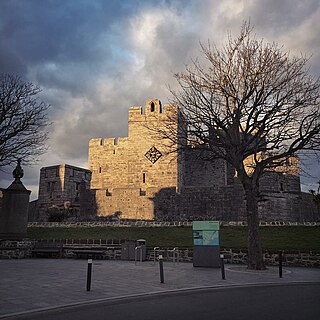
Castle Rushen is a medieval castle located in the Isle of Man's historic capital, Castletown, in the south of the island. It towers over the Market Square to the south-east and the harbour to the north-east. The castle is amongst the best examples of medieval castles in Europe and is still in use as a museum and educational centre.
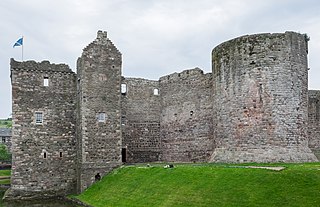
Rothesay Castle is a ruined castle in Rothesay, the principal town on the Isle of Bute, in western Scotland. Located at NS086646, the castle has been described as "one of the most remarkable in Scotland", for its long history dating back to the beginning of the 13th century, and its unusual circular plan.

Clan Stewart (Gaelic: Stiùbhart) is a Scottish Highland and Lowland clan. The clan is recognised by Court of the Lord Lyon; however, it does not have a Clan Chief recognised by the Lord Lyon King of Arms. Because the clan has no chief it can be considered an armigerous clan; however, the Earls of Galloway are now considered to be the principal branch of this clan, and the crest and motto of The Earls of Galloway's arms are used in the Clan Stewart crest badge. The Court of the Lord Lyon recognises two other Stewart/Stuart clans, Clan Stuart of Bute and Clan Stewart of Appin. Clan Stuart of Bute is the only one of the three clans at present which has a recognised chief.
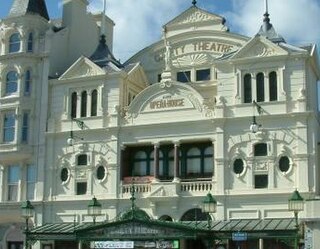
The Gaiety Theatre and Opera House is a theatre in Douglas, Isle of Man which together with the Villa Marina forms the VillaGaiety complex. The Gaiety is situated on Douglas promenade, overlooking the sea and adjacent to the Villa Gardens, Arcade and Butts.

The lieutenant governor of the Isle of Man is the Lord of Mann's official personal representative in the Isle of Man. He has the power to grant royal assent and is styled "His Excellency".
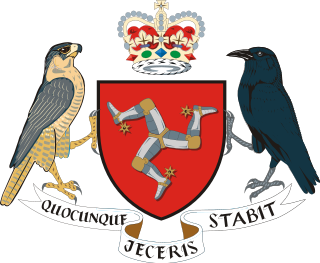
The Lord of Mann is the lord proprietor and head of state of the Isle of Man, currently King Charles III. Before 1504 the title was King of Mann.

Douglas Harbour is located near Douglas Head at the southern end of Douglas, the capital of the Isle of Man. It is the island's main commercial shipping port. The Port of Douglas was the first in the world to be equipped with radar.

Cornelius Smelt was an administrator who served as Lieutenant Governor of the Isle of Man from 1805 until his death in 1832, the longest governorship in the history of the Island. An officer in the British Army, he served first with the 14th Regiment of Foot and then the 35th Regiment of Foot, acting as Deputy Governor of Southsea Castle in the late 18th century. His governorship of the Isle of Man is remembered as one in which he displayed great moral courage in difficult circumstances. His wisdom and fortitude in the long period when the House of Keys and the Duke of Atholl fought their historic political battles were also evident. Upon his death, a memorial was erected in Castletown in the Isle of Man.
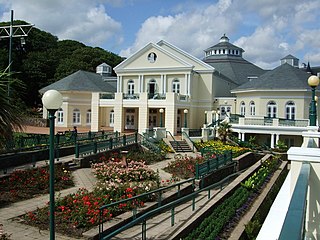
The Villa Marina is an entertainment venue in Douglas, Isle of Man, which forms part of the wider Villa-Gaiety complex. It is located on Harris Promenade, looking out onto Douglas Bay, and comprises the Royal Hall, Broadway Cinema, Promenade Suite, Colonnade Suite,Dragon's Castle and the Villa Marina Gardens. The architect was Alban Jones, whose design was chosen in an open competition judged by Professor Adshead of Liverpool University.

St Andrew's Church, Andreas, is a Church of England parish church in Andreas, Isle of Man. The church is administered by the Diocese of Sodor and Man.

George Steuart was a Scottish architect. Although native to the province of Atholl in Perthshire, Steuart spent most of his adult life in London, before moving to the Isle of Man in his final years. The lifelong patronage of the Dukes of Atholl assisted him greatly in his architectural career. Surviving examples of his work include Attingham Hall and St. Chad's Church in Shropshire, and Castle Mona in the Isle of Man.



